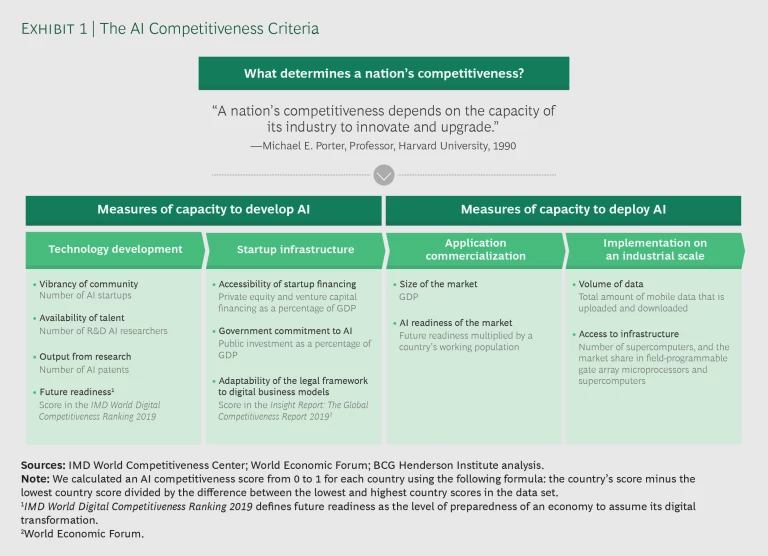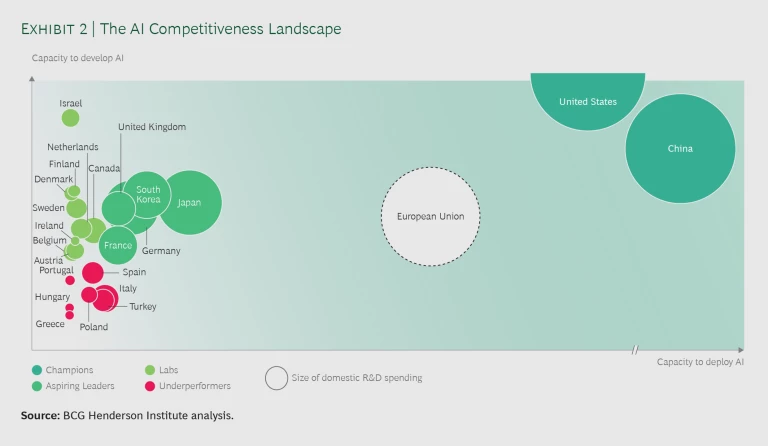This is the second in a series of articles about the future of technology in Europe. Here, we focus on the policies that the EU must change to become more competitive in artificial intelligence.
There’s a growing consensus that in the field of artificial intelligence (AI), the European Union (EU) lags behind China and the US. Even Thierry Breton, the European Commissioner for Internal Market, recently admitted that the EU missed the first wave of AI. During that wave, AI was used mainly in consumer applications, such as search engines and speech recognition. In the imminent second wave, industrial applications of AI—such as predictive maintenance and quality control that are based on image recognition—will spread through the global economy.
Although the European Commission has recently unveiled its ambitious plans in a document titled Shaping Europe’s Digital Future: Strategies for Data and AI, policymakers and leaders alike believe that the EU won’t catch up with the global leaders in AI anytime soon. Two years ago, former Google China president, venture capitalist, and AI expert Kai-fu Lee bluntly stated that Europe wasn’t in the running for even a bronze medal in the global AI race. In another interview, Lee added that the US will “continue its hegemony…in Western Europe” in AI. That begs the question: can the EU ever catch up?
The good news: not all is lost. There’s enormous potential for the development and deployment of AI technologies in the EU because it has a large number of world-class, global companies that are industry leaders. However, realizing that potential requires far-reaching policy reforms that enable the EU’s industry players to use AI at scale in their operations. The EU holds several aces in its hand, but it must play them right away.
Read more of the series
- As the COVID-19 Crisis Reveals, Europe Urgently Needs to Digitize Its Industry
- Europe Can Catch Up in AI, But Must Act—Today
- How Digital Giants and Europe Can Cooperate to Win in AI
How the EU Compares on AI Competitiveness
To understand how members of the EU compare with other countries, BCG Henderson Institute developed a set of criteria to measure the AI competitiveness of several economies. (See Exhibit 1.) The research drew on the following definition from Harvard University professor Michael E. Porter: “A nation’s competitiveness depends on the capacity of its industry to innovate and upgrade.” Our objective was to help policymakers and executives make decisions and take actions, so we focused on AI’s economics, rather than its impact on areas such as the environment or the future of work.
The analysis concentrated on two aspects. The first was whether a country has the capacity to develop AI. We considered several factors in determining a country’s capacity, including the local availability of the right kind of talent and the accessibility of startup funding by private-sector and government players.
The second aspect that we analyzed was whether a country had the capacity to deploy AI. To assess this, we considered whether companies developing AI applications could commercialize them and implement them at scale in local industries. These companies would need access to an AI-ready market, ample local data to train algorithms so that they can be used effectively, and sufficient infrastructure, such as supercomputers.
Our analysis shows that in terms of AI competitiveness, countries can be categorized into four groups: champions, aspiring leaders, labs, and underperformers. (See Exhibit 2.)
Champions. China and the US have developed enormous innovation capabilities and excel at using AI to improve productivity. They are light years ahead of every other country in the world.
Aspiring Leaders. France, Germany, Japan, South Korea, and the UK have reached the threshold level of innovation capability, and, because of large domestic industries, they also possess an AI-ready market. Importantly, if we were to treat the EU as one country—that is, if we were to assess the combined capacity of all member countries—it would be closer to the champions in terms of AI competitiveness. However, as we demonstrate later, the EU is a highly fragmented market.
Labs. Countries such as Denmark, Finland, Ireland, the Netherlands, and, in the EU’s proximity, Israel have all developed the capacity to innovate, with Israel even at par with the champions in this regard. However, industries in these countries don’t have the scale to fully benefit from their nation’s capabilities. As a result, these countries are entirely dependent on other countries to capitalize on the AI that they’ve developed, which is unlikely to lead to AI competitiveness. These countries will be able to become more competitive only by negotiating mutually beneficial partnerships with companies and countries outside the EU.
Underperformers. Most Southern and Eastern EU economies (including, for example, Italy) haven’t built their innovation capabilities to a global level yet. They also possess a limited capacity to deploy AI.
The EU’s Paths
To catch up with the global leaders, the EU’s economies have to take paths that reflect their current competitive positions.
First, the underperformers must upgrade their fundamental capabilities, such as talent and funding, to support business innovation. Without those capabilities, they will find it difficult to develop industrial AI applications.
The silver lining is that improving innovation capabilities has been the priority in the 18 national AI plans that we studied. That focus has yielded impressive results: the EU has 5.7 million AI developers, leading both China and the US, according to Atomico. Still, as of the first quarter of 2020, the EU has spawned only 4 AI unicorns, compared with 11 in China and 28 in the US, according to our research.
Second, the aspiring leaders and labs should strike global partnerships to expedite the business application of their technologies. These countries face a stiff challenge: when companies around the world seek partnerships, digitally mature companies from China and the US are usually the most attractive options. That’s because innovation capabilities are only one criterion; companies’ ability to use AI at scale is equally critical—a competency that companies in China, in particular, have clearly demonstrated.
Aspiring AI leaders should strike partnerships to expedite the business application of their technologies.
Why China Excels—and the EU Lags
Although the EU has equally well-developed innovation capabilities, China has pulled ahead in developing and deploying AI technologies because of the country’s capacity to get its companies to adopt AI technologies. In fact, China has become a champion because it meets all the requirements needed to deploy AI applications at scale.
China excels in commercializing AI because the size of its economy creates a large market for such applications. In addition, coordinated government support has resulted in the rise of an adequate number of industrial ecosystems, neither too few nor too many (as there are in the EU). Importantly, these ecosystems, and the participants in them, are AI ready; China’s digital ecosystem orchestrators—such as Alibaba, Tencent, and Haier—play a key role in ensuring that. For example, Alibaba.com and JD.com digitized one-third of China’s retail stores in less than two years’ time. Having proactively digitized small and medium enterprises, these companies now exert a digital pull in many industries.
Vast amounts of the data required for machine learning are also available in China because of public and private initiatives. For example, MBH, one of China’s largest data-labeling companies, already employs 300,000 data labelers; early in 2020, MBH indicated that it hoped to grow its workforce by 50%. In addition, China has the largest number of supercomputers in the world, which is an advantage. In 2019, it hosted about 40% of the 500 most powerful computers in the world, according to Top500.org, while the EU and even the US hosted only about 20% each.
By comparison, the EU has struggled to successfully commercialize AI at scale. The market has been highly fragmented, although a unified EU market may be potentially large. Because the policy incentives that are in place encourage national ecosystems, they result in the creation of subscale national monopolies, rather than the making of potential EU champions. Brexit will only make fragmentation worse; the UK accounted for about 70% of AI investments in the EU from 2008 through 2019.
Moreover, EU companies and industries aren’t AI ready. They trail those in China and in the US in terms of digitization. One reason is the lack of direct pull from digital ecosystem orchestrators. As a result, EU companies have a long way to go before they will be AI ready.
Access to data also remains fragmented in the EU, and although language differences play a part, those can be overcome. The revised Public Sector Information Directive and the recently unveiled European Strategy for Data will go a long way to ensure that governments and companies share data, but much more needs to be done in this area.
Finally, the EU’s computing foundations are weaker than China’s. Most of the world’s quantum computing companies, cloud service providers, and chip manufacturers aren’t based in member countries. New EU initiatives—such as Quantum Flagship, which plans to invest €1 billion over ten years to develop quantum computers—will help, but such programs risk being too focused on research. And even these efforts lack scale, compared with those in, say, China, which invested $10 billion in the National Laboratory for Quantum Information Sciences.
How the EU’s Policies Must Change
The EU is trying to catalyze the industrial application of AI at scale, but major shifts in thinking will be necessary to ensure the effort succeeds. The newly installed European Commission has to shift policy dramatically in three ways:
- Expand the EU’s Digital Single Market. The EU has announced several initiatives to expand the Digital Single Market. One such initiative is the creation of common data spaces in the EU for strategic sectors. However, to foster an AI-enabling market, the EU has to bring about more sweeping changes. Member countries must support the development of ecosystems at the EU level, rather than at the national level. They must tackle the fear that competition will rise because of data integration and pool their national incentives. Without pan-EU ecosystems, the Digital Single Market is unlikely to become a reality.
Member countries must support the development of ecosystems at the EU level, rather than at the national level.
- Ensure AI sovereignty. European Commissioner Breton rightfully poses that the EU cannot make its digital transition happen without AI sovereignty. The EU needs to access the most advanced AI-enabling technologies and data in the world, and it must apply them according to EU rules and values. Although the European Commission’s data strategy, presented in February 2020, is a good first step, much more has to be done. It’s critical for the governments of member countries to learn to dance with the world’s digital titans, but the governments must do so only on their terms. Cooperating with companies that are more committed to EU AI sovereignty is the only way that the EU can become more AI competitive.
- Drive scale in AI usage. The EU’s policymakers have proposed many industrial programs—such as the Important Projects of Common European Interest in 2018 and the screening of foreign direct investments—to provide a fillip to the deployment of AI in its industries. Although these programs play an important role, they can easily turn into protectionist policies or be perceived that way globally. With the world’s attitude toward globalization changing, the EU has to walk a fine line, so that it ensures a level playing field for its companies without adopting a protectionist posture.
How EU Businesses Must Lead the Charge
If the EU is to become more AI competitive, EU companies will have to play a pivotal role. They must work with foreign corporations not only because it is a necessity but also because it will prove to be mutually beneficial.
The EU’s automotive manufacturing segment is proof of all that its industry has to offer. Automobile manufacturers (such as Volkswagen Group, Mercedes-Benz, and Fiat Chrysler, which is completing its merger with PSA Group) own the connection to the customer, the manufacturing capacity, the industrial data, and the production ecosystem. Although AI hardware and software players from around the world (such as Intel’s Mobileye and Google’s Waymo) are taking the lead in developing autonomous driving technologies, they will not make much headway in the EU on their own. That’s why Waymo has teamed up with Fiat and Tesla had tied up with Daimler. The EU auto majors are in a position to demand partnerships on an equal footing. Rather than sticking to the transactional level, they should strike relationships that include long-term knowledge and data sharing.
To do that, EU companies have to change their mindset. In addition, they have to become more AI ready if they are to be regarded as attractive partners for companies from China and the US. They can draw inspiration from Amazon’s legendary Bezos Mandate. In 2002, Amazon founder and CEO Jeff Bezos sent a note insisting that the company’s software teams would share data, functionality, and communications only through service interfaces, and that all service interfaces, without exception, would have to be designed so that they could be shared with developers in the outside world. That’s the kind of radical thinking that’s needed today if EU Inc. is to come from behind and win the AI race.








